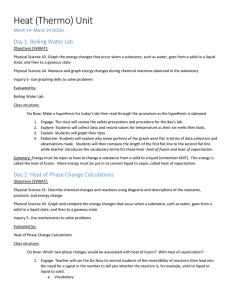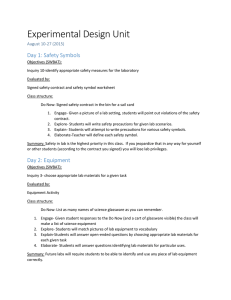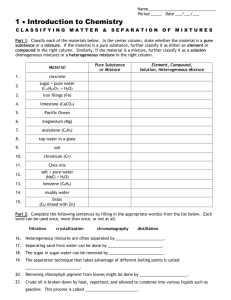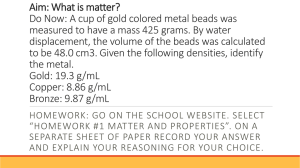Objectives (SWBAT)
advertisement
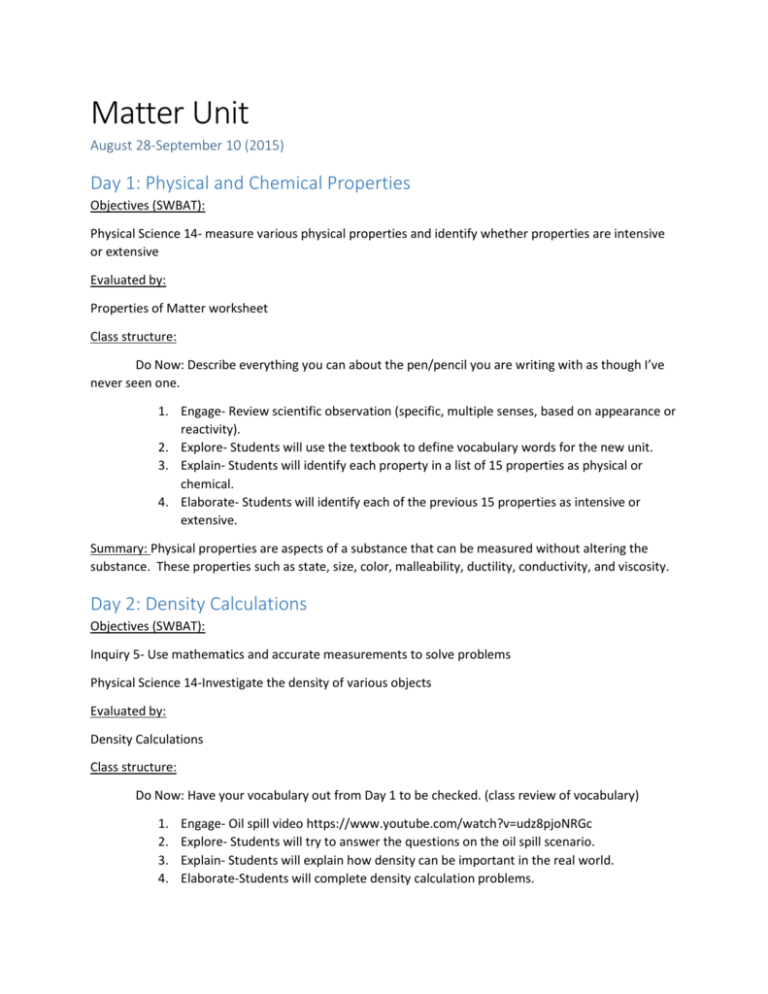
Matter Unit August 28-September 10 (2015) Day 1: Physical and Chemical Properties Objectives (SWBAT): Physical Science 14- measure various physical properties and identify whether properties are intensive or extensive Evaluated by: Properties of Matter worksheet Class structure: Do Now: Describe everything you can about the pen/pencil you are writing with as though I’ve never seen one. 1. Engage- Review scientific observation (specific, multiple senses, based on appearance or reactivity). 2. Explore- Students will use the textbook to define vocabulary words for the new unit. 3. Explain- Students will identify each property in a list of 15 properties as physical or chemical. 4. Elaborate- Students will identify each of the previous 15 properties as intensive or extensive. Summary: Physical properties are aspects of a substance that can be measured without altering the substance. These properties such as state, size, color, malleability, ductility, conductivity, and viscosity. Day 2: Density Calculations Objectives (SWBAT): Inquiry 5- Use mathematics and accurate measurements to solve problems Physical Science 14-Investigate the density of various objects Evaluated by: Density Calculations Class structure: Do Now: Have your vocabulary out from Day 1 to be checked. (class review of vocabulary) 1. 2. 3. 4. Engage- Oil spill video https://www.youtube.com/watch?v=udz8pjoNRGc Explore- Students will try to answer the questions on the oil spill scenario. Explain- Students will explain how density can be important in the real world. Elaborate-Students will complete density calculation problems. Summary: An intensive property is one that depends only on the type of material, not the amount of material (color, odor, density, reactivity, etc). An extensive property is one that depends on the amount of material (mass, volume, length). Density is an intensive property despite the fact that it is calculated from two extensive properties (mass/ volume). Day 3: Density Lab Objectives (SWBAT): Inquiry 5- Use mathematics and accurate measurements to solve problems Physical Science 14-Investigate the density of various objects Evaluated by: Density Lab Class structure: Do Now: What is density (definition and/or formula) and is it an intensive or extensive property? 1. 2. 3. 4. Engage- Demo of density and its ability to rearrange fluids (oil, water, and corn syrup). Explore- Students will complete the density lab, being careful to measure precisely. Explain- Students will show all work for calculations. Elaborate- Students will complete the density calculations for homework if necessary. Summary: Density is a physical property of a substance that refers to how tightly packed the particles of the substance are. This is calculated by dividing the mass (amount of stuff in an object) by the volume (the amount of space the object takes up). Day 4: Classifying Matter Objectives (SWBAT): Physical Science 14- Identify unknowns as elements, compounds, or mixtures; differentiate between physical and chemical properties; describe states of matter using physical properties and KMT Evaluated by: Element/Compound/Mixture Microscopic Scale worksheet Class structure: Do Now: What is the density of an object with a mass of 6g that, when dropped, raises the volume in a graduated cylinder from 3 mL to 5 mL? 1. Engage- Students will use a word bank, prior knowledge, and a textbook to fill in a flow chart describing how to classify matter. 2. Explore- Students will classify various substances as elements, compounds, homogeneous mixtures, or heterogeneous mixtures. 3. Explain- Students will explain their classifications in a think/pair/share activity. Teacher will review the definitions for and examples of colloids, suspensions, and solutions. 4. Elaborate- Students will apply their definitions and flow chart to the microscopic scale to complete the element/compound/mixture worksheet. Summary: Physical properties can be used to classify matter. In a pure substance, the physical properties are the same. In a mixture, each component can have distinct properties. Day 5: Separating Matter Objectives (SWBAT): Physical Science 14- Identify unknowns as elements, compounds, or mixtures; differentiate between physical and chemical properties; describe states of matter using physical properties and KMT Evaluated by: Exit Ticket- Examples and explanation for methods of separation (looseleaf) Class structure: Do Now: Given the picture below, identify each box as element, compound, solution, or heterogeneous mixture. 1. Engage- Students will double check Day 4’s worksheet before they turn it in for a grade based on the answers to the Do Now. 2. Explore- NOTES: Types of separation a. Filtration to separate heterogeneous mixtures by size b. Physical Separation to separate heterogenous mixtures by a visible difference c. Magnetism to separate out Fe, Ni, or Co out of a heterogeneous mixture d. Chromatography to separate solutions by the charges or polarities of the components e. Distillation to separate solutions by the boiling points of the components f. Evaporation to separate a liquid from a dissolved solid 3. Explain- Students will give an example of when each type of separation would be used (except chromatography) and write at least two sentences explaining why these methods cannot be used to separate a pure substance. 4. Elaborate- Teacher will show a video about distillation http://www.youtube.com/watch?v=IPXjuOKgUMo Summary: Mixtures can be separated by physical properties. This can occur as filtration, distillation, physical separation, magnetism, chromatography, or evaporation. Day 6: Physical and Chemical Changes Objectives (SWBAT): Physical Science 31- Distinguish chemical changes from physical changes based on evidence; describe chemical changes by identifying reactants, products, and energy changes Evaluated by: Physical/Chemical Change Lab Class structure: Do Now: When is evaporation used to separate a mixture? How is this different from when filtration is used? 1. Engage- Pre-lab Questions (10 minutes) 2. Explore- Record observations made through your senses of sight and touch for each of the eight stations (20 minutes) 3. Explain- For each of the stations observed, students will determine whether the change was physical or chemical and if there was any energy (heat) input or output. 4. Elaborate- Students will complete the post-lab questions. Summary: The difference between physical and chemical changes is that chemical changes produce a new material. Some signs that a new material has been produced include light, heat, odor, color change, gas evolution, or formation of a precipitate. Day 7: Review and Organize Objectives (SWBAT): Inquiry 5 and Physical Science 14, 21, 31, and 38 Evaluated by: Test Review Class structure: Do Now: Is burning a log considered a physical or chemical change? 1. Engage- Students will finish up the post-lab questions from Day 7’s lab then the teacher will review the big ideas and vocabulary from the unit. 2. Explore- Students will work on their test review 3. Explain- Students will pair with a partner to correct one question for each person in the review packet (think/pair). 4. Elaborate- Students will organize their binders to determine which sections of the unit they need to review the most. Summary: The easiest way to study is to stay organized so you can review your notes and classwork daily. 10 minutes a night will go a long way to committing this new information to memory. Day 8: Test- Matter Objectives (SWBAT): Inquiry 5 and Physical Science 14, 21, 31, and 38 Evaluated by: Test- Matter and its properties Class structure: Do Now: Take out a calculator and something to write with, open your binder to the table of contents and place it on the back bench, move your bags to the A/C, and clear your calculator RAM TEST Summary: We have covered chapters 1-3 in the Pearson Chemistry textbook. The exam in October will GLE Objective Day(s) Addressed Inquiry 5 Utilize mathematics, organizational tools, and graphing skills to solve problems 2, 3 Physical Science 14 Identify unknowns as elements, compounds, or mixtures based on physical properties 1, 2, 3, 4, 5 Physical Science 21 Design and conduct a laboratory experiment in which physical properties are used to separate the substances in a mixture 5 Physical Science 31 Describe chemical changes and reactions using diagrams and descriptions of the reactants, products, and energy changes 6 Physical Science 38 Relate the law of conservation of matter to the rearrangement of atoms in a balanced chemical equation 6 cover chapters 1-5 so be sure you are keeping up. Vocabulary Intensive Transparent Heterogeneous Mixture Extensive Hardness Colloid Physical Property Luster Suspension Chemical Property Density Tyndall Effect Malleable Element Physical Change Ductile Compound Chemical Change Viscosity Solution Equation Density= mass/volume Assessment Design- Unit 2 Basic: 6 Questions Standard: 12 Questions Expanded: 6 Questions Essential Skills and Learning Objectives Type of Question (MC, CR, P) Basic (Remember & Understand) Standard (Apply & Analyze) Expanded (Evaluate & Create) Differentiate between physical and chemical properties CR/ MC 1 CR 2 MC 3 MC 1 CR Identify unknowns as elements, compounds, or mixtures based on physical properties MC/ CR Calculate density CR/ MC 1 CR 1 MC 1 CR 1 CR Use physical properties to separate the substances in a mixture CR 5 CR Describe reactions as physical or chemical changes and use reactants, products, and energy changes to distinguish these MC/ CR 1 MC 2 CR 1 CR Relate the law of conservation of matter to the rearrangement of atoms in a balanced chemical equation MC/ CR 1 MC 1 CR 1 CR 1 CR

